 alt="Multihull Special 2023: Powercats Part 2"/>
alt="Multihull Special 2023: Powercats Part 2"/>
Note: The following is Part Two of a powercat article in Issue 71 (click to read Part One) and follows a chapter on supercats (click to read)
Leopard, which has built over 2,500 catamarans over the past two decades, had a world premiere at this year’s Miami international Boat Show, with the new 40 Powercat (see Review) completing the builder’s new family of powercats developed by Simonis Voogd Design. The model’s first unit in Asia is scheduled to arrive in April 2024.
The brand’s catamarans are built by Robertson & Caine in Cape Town in South Africa and are also used under different names by sister charter companies, The Moorings and Sunsail. Leopard is another pioneer of power catamarans and sold about 140 units of its former 51PC, the brand’s first design by Simonis Voogd, plus over 100 units of the 43PC.
The 51 was succeeded in 2020 by the 53 Powercat, the brand’s current flagship, which only made its show debut in Asia at this year’s Singapore Yacht Festival despite the first units in the region being delivered in 2021.
The next member of the new family was the 46 Powercat, which debuted at Miami last year, with the 40 rounding out the new-look powercat family, which have the option of solar panels and lithium batteries and are produced in parallel to the 42, 45 and 50 sailing cats, which use different hulls.
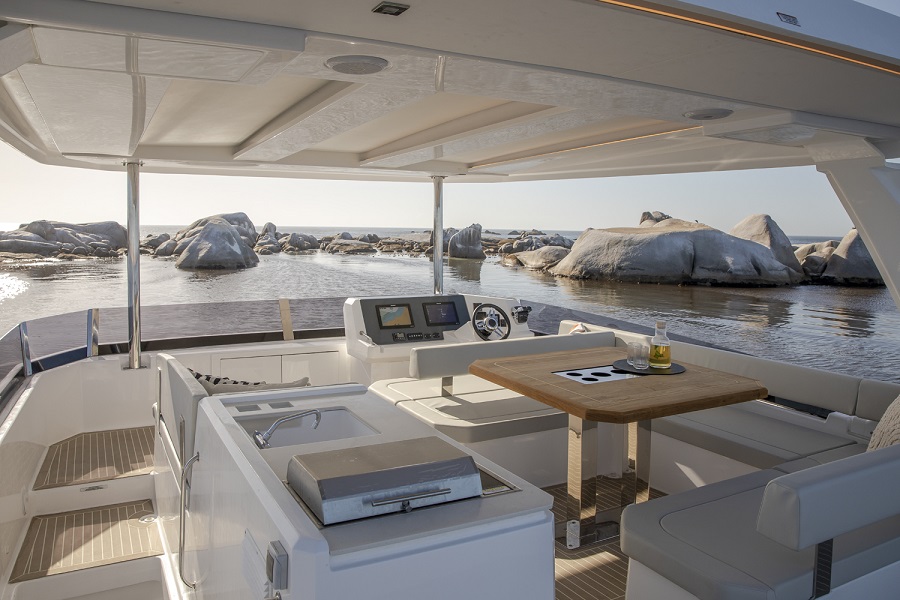
Leopard 40 Powercat
Leopard’s powercats have been catching up with its sailing models in terms of popularity around the world, while they have traditionally outsold their masted sisters in Asia. Since the beginning of last year, over a dozen Leopards have been delivered to Asia including seven powercats: the former 43 to Malaysia, the 46 to China, Malaysia and Philippines, and the flagship 53 to Indonesia and two to the Philippines.
“Overall, the response for the new line of powercats has been very positive, with half-a-dozen already delivered to Asia and more to follow. The 40 Powercat launched recently, but we expect it to be popular as there aren’t many boats in the 40ft range offering the same amount of space and comfort,” says Kit Chotithamaporn, Leopard’s Yacht Sales Manager – Asia.
“In general, Leopard’s entire powercat range offers great performance with a top speed over 20 knots yet efficient in fuel consumption, especially at passage-making speeds. The space and layout of Leopard’s powercats are other great selling points, especially the huge flybridge with hard top.”
FRENCH CAT SPECIALISTS
Fountaine Pajot has produced over 4,000 catamarans since 1976, moving into powercats just over two decades later.
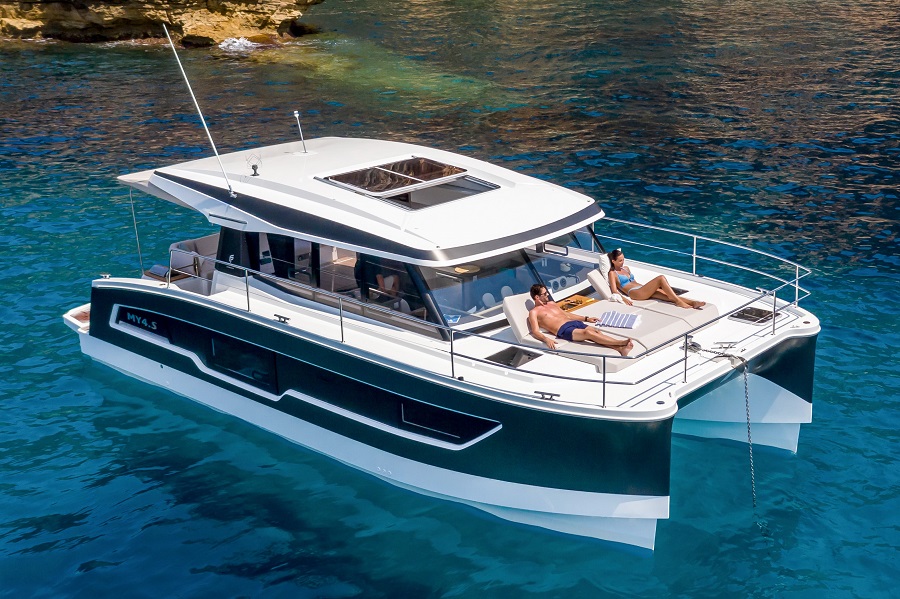
Fountaine Pajot MY4.S
The La Rochelle builder’s current motor yacht range comprises the MY4.S sedan (37ft), MY5 and MY6 (formerly MY40 and MY44), plus the Power 67 that had its official world premiere at last year’s Cannes Yachting Festival. The shipyard recently hosted clients and prospects for private sea trials on the MY4.S, MY6 and Power 67.
Asia Yachting has represented the brand’s motor yachts in Hong Kong since 2021 and started by selling an MY5. However, it says the larger MY6 – on display at the Asia Yachting Boat Show in May – has been the brand’s most popular powercat in Hong Kong, as it’s a large-volume powercat that only requires a Grade 2 skipper’s licence.
“Fountaine Pajot powercats perform well at sea and are well finished, very practical, feature an excellent use of space and are good value for money considering the volume,” says Olivier Besson, founder and CEO of Asia Yachting. “The shipyard is constantly fine-tuning and improving the models following owner’s feedback, not only waiting for when a new model or upgrade is launched.”
Lagoon’s powercat range still comprises the Lagoon Seventy 8 that launched in 2017, a year after the Seventy 7 sailing cat, and the Sixty 7, which debuted in 2019, a year ahead of its sister sailing cat, the Sixty 5.
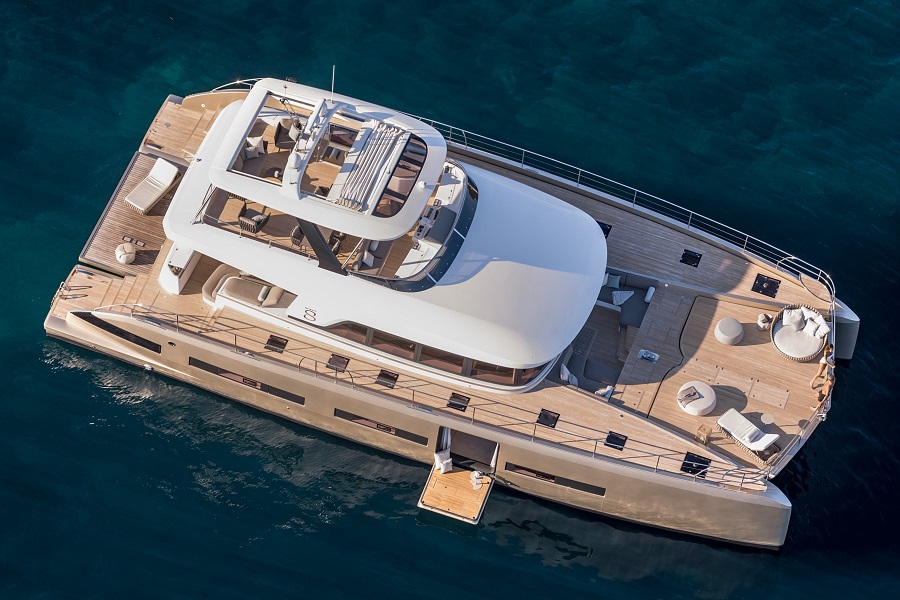
Lagoon Seventy 8
The builder, which will celebrate its 40th anniversary in 2024, has a solid network of long-standing distributors across Asia including Simpson Marine in Greater China and much of Southeast Asia, while Europa Yachts handles a busy market in the Philippines.
Recent powercat deliveries have included a Seventy 8 in Hong Kong last December, with another unit of the flagship due in Hong Kong this summer, while the model is already present in the Philippines, home to the model’s first hull. A new Sixty 7 was delivered to the Philippines in January, while the model has also been delivered to Hong Kong, Singapore and Taiwan.
ECO LEADERS
Sunreef, represented in Singapore by Hong Seh Marine and Thailand by Lee Marine, has taken the production of large powercats to another level in terms of size, finishing and customisation. However, the core of the Polish builder’s motor yacht range is still based around its 60 Power, 70 Power and 80 Power, all unveiled in the company’s ‘New Beginnings’ era.
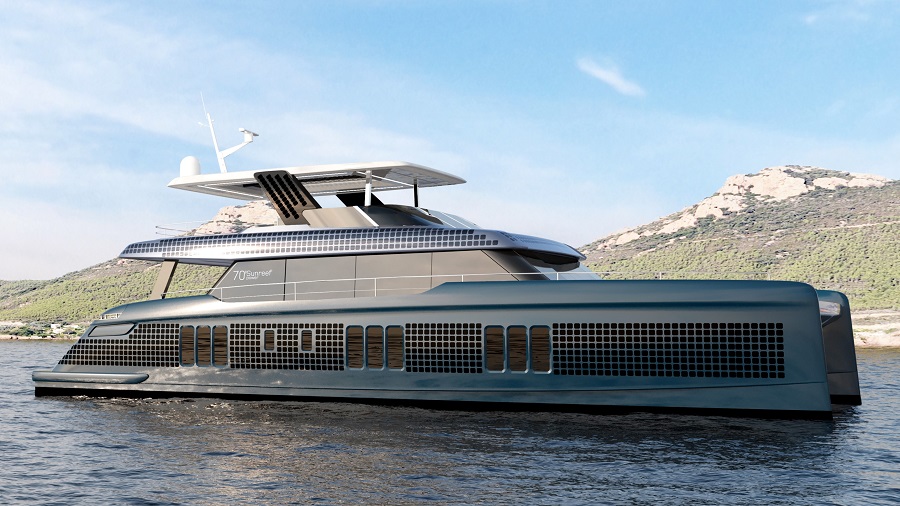
CGI of 70 Sunreef Power Eco
All three models – and larger ones like the 100 Power launched in 2021 – are now available in Eco versions, which offers the shipyard’s revolutionary photovoltaic system, electric engines, lithium battery bank and linen/basalt structural elements, while options include wind turbines and a kite sail.
New technology also includes what Sunreef describes as the industry’s most efficient air-conditioning system and high-tech water maker and purification system. This year’s upcoming deliveries include the first 60 Sunreef Power Eco and an 80 Sunreef Power Eco, while further orders for both models were signed last year.
Sunreef, founded in Gdansk in 2002, has revealed an even newer generation of powercats that will be built in the shipyard’s new production facility in Ras Al Khaimah in the UAE. Originally announced as the 55 Open Sunreef Power, the 55 Ultima along with the 44 Ultima are hybrid ‘eco-speeders’ available in Eco versions with solar panels fitted on the hard top.
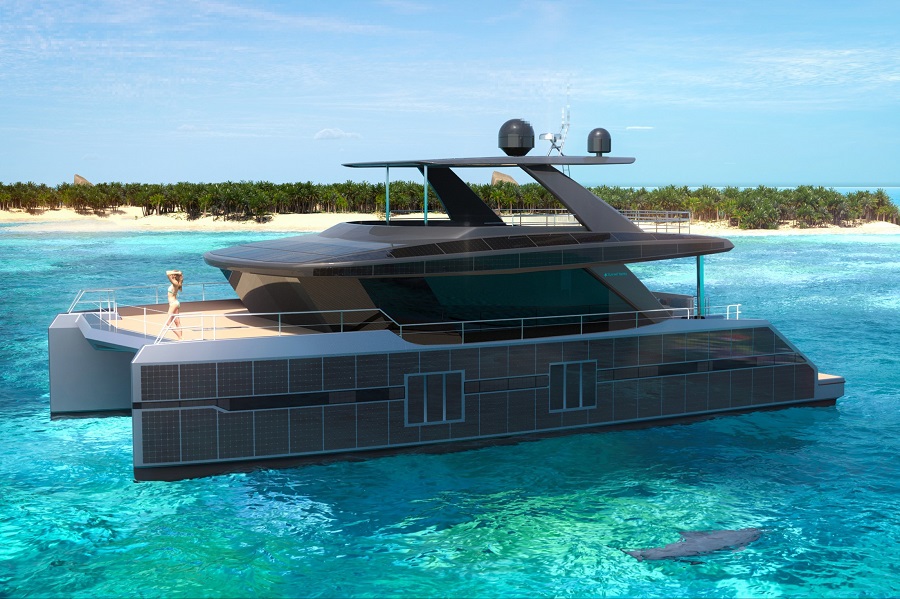
CGI of Sunreef Supreme 70 Power Eco
The Ras Al Khaimah facility will also produce the Supreme 70 Power Eco and Supreme 80 Power Eco models, which have the same length and width as the 70 Power and 80 Power but feature sharper lines, a forward-ranked windscreen, forward-angled hard top supports, and a huge aft garage able to house a tender, jet-ski, diving gear and other water toys.
Silent-Yachts, now represented by Asiamarine in Hong Kong, Singapore and Thailand, is the original pioneer of solar-electric catamarans and is currently busy catching up with orders for its 60, 62 3-Deck, 80 and 80 3-Deck production models.
The more popular 3-Deck versions of both the 60/62 and 80 offer a large flybridge social area with dedicated hard top and are available in Open or Closed versions, the latter featuring an enclosed skylounge forward.
Founded and owned by Austrian Michael Köhler, the company started with Köhler’s own Solarwave 46 from 2009 followed by the Silent 64 built in Turkey and Silent 55 built in China, the company’s first production models.
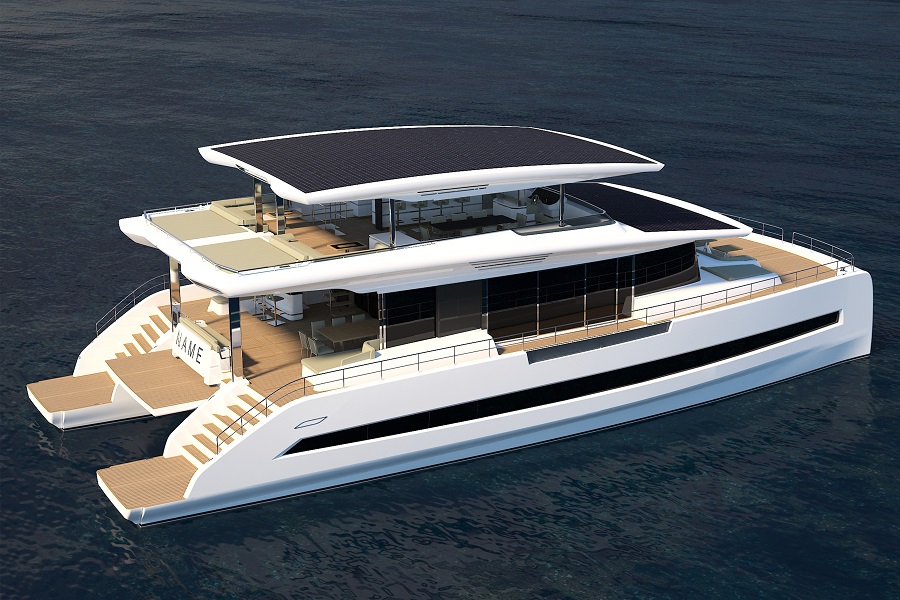
CGI of Silent 80 3-Deck Open
After the first few units of the Silent 60 were built in Thailand, all subsequent 60/62 builds and all the 80 models are being built between the shipyard’s own factory in Fano on Italy’s east coast and at VisionF’s facilities in Turkey following a collaboration between the two builders after the 2021 Cannes Yachting Festival.
Stella, the first Silent 60 produced in Italy, was launched earlier this year and features 42 solar panels for 16kWp of solar energy, two 250kW electric motors and a top speed of 14 knots. Backed up by a battery capacity of up to 210kWh, she’s able to cruise emission-free solely on solar power for up to 100nm a day.
Silent-Yachts is also collaborating on the aluminum VisionF 82, a solar-assisted hybrid and slightly redesigned version of the existing VisionF 80 produced by the Istanbul shipyard founded in 2019 by Coskun Bayraktar. The Turkish builder has already delivered at least three units of the VisionF 80, with several more hulls in production.
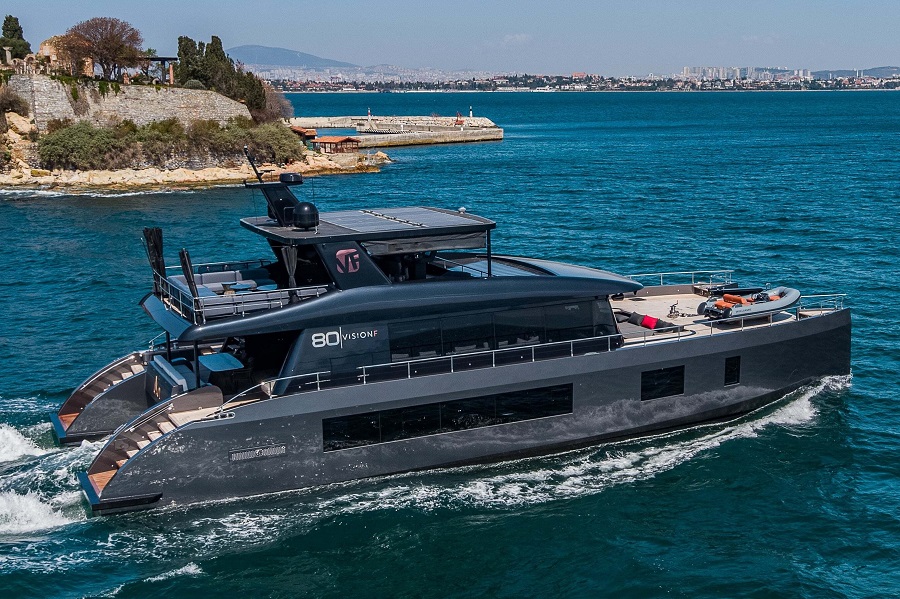
VisionF 80
VisionF is currently developing the VisionF 60, which is built in GRP and has a remarkable beam of 10m (33ft) – making it wider than the VisionF 80 – while it’s designed to have a draft of just 0.65m fully loaded.
Standard propulsion is two 360hp Volvo Penta IPS 600 diesel engines for a top speed of 21 knots, while solar panels can be added to the top surfaces and work with an integrated battery-management system to power some of the hotel load.
MORE BRANDS COMING
Meanwhile, Italy’s Bluegame is set to enter the market with the BGM75, which features a smooth, elegant profile and exterior designed with Zuccon International Project, while Philippe Briand collaborated on the concept and naval architecture, with Lissoni & Partners handling layout and interiors.
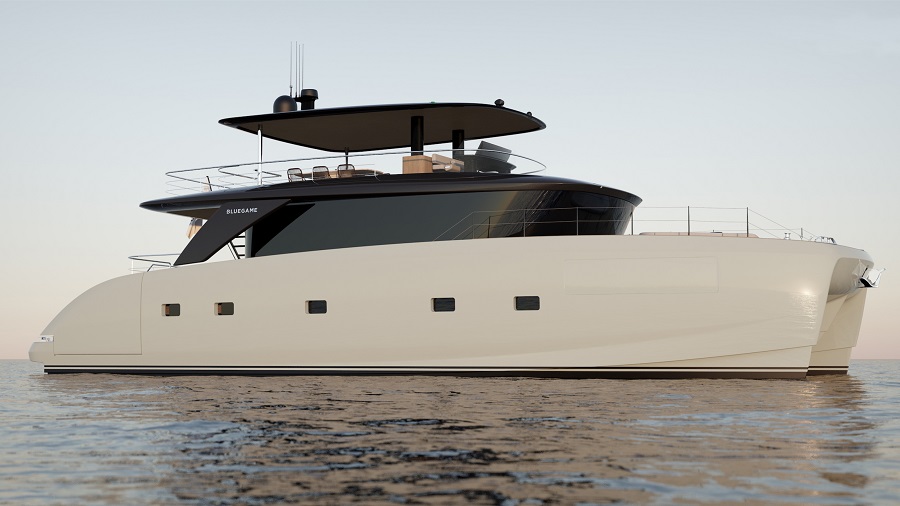
CGI of Bluegame BGM75
BGM75 has an overall length of 22.7m (74ft 4in) and a relatively slim beam of 8.15m (26ft 7in), which enables the lower deck to span the width of the yacht and feature a full-beam owner’s suite forward plus two or three guest cabins – depending on whether the galley is up or down – plus a crew quarters.
The yacht has two 550hp or 625hp Volvo Penta D8-IPS engines and a single helm on the flybridge, while a huge aft swim platform includes a drop-down central section to deploy the tender.
US builder Lazzara Yachts is also moving into power catamarans with the LPC 70, which has a length of 21.3m and a beam of 8.85m (29ft), with the first unit scheduled for delivery to the Mediterranean in 2024.
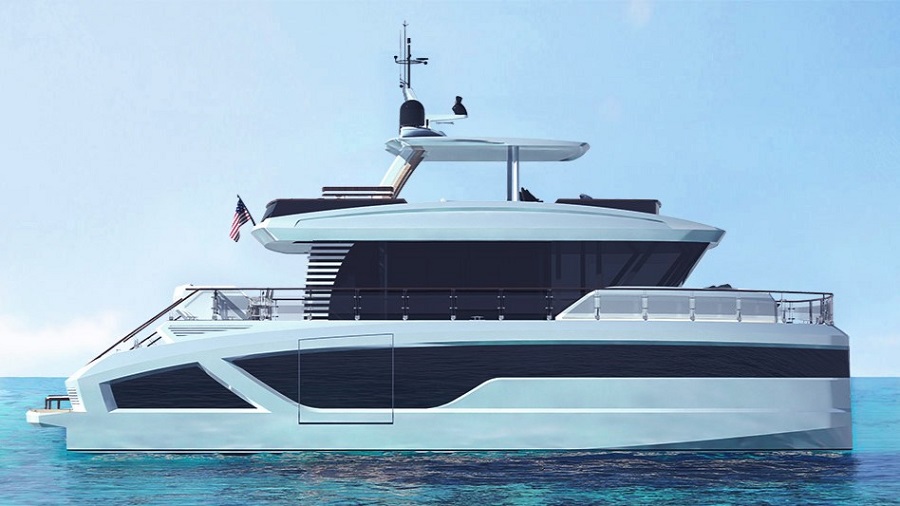
CGI of Lazzara LPC 70
Like the Prestige and Bluegame designs, the LPC 70 has a full-beam lower deck, but features a full-width owner’s suite aft with direct access to the beach club, while forward are four guest cabins and two crew cabins either side of a half-height forward galley.
On the main deck, the helm is on starboard side of the dining area, aft is the saloon and cockpit, while the flybridge has a hot tub, Texas-style barbecue, high bar for cocktails, covered dining and upper helm. Lazzara expects a top speed of 28-plus knots and a comfortable cruising speed of 18 with two 1,000hp Volvo Penta D13-IPS1350, plus a range of 1,000nm in displacement mode.
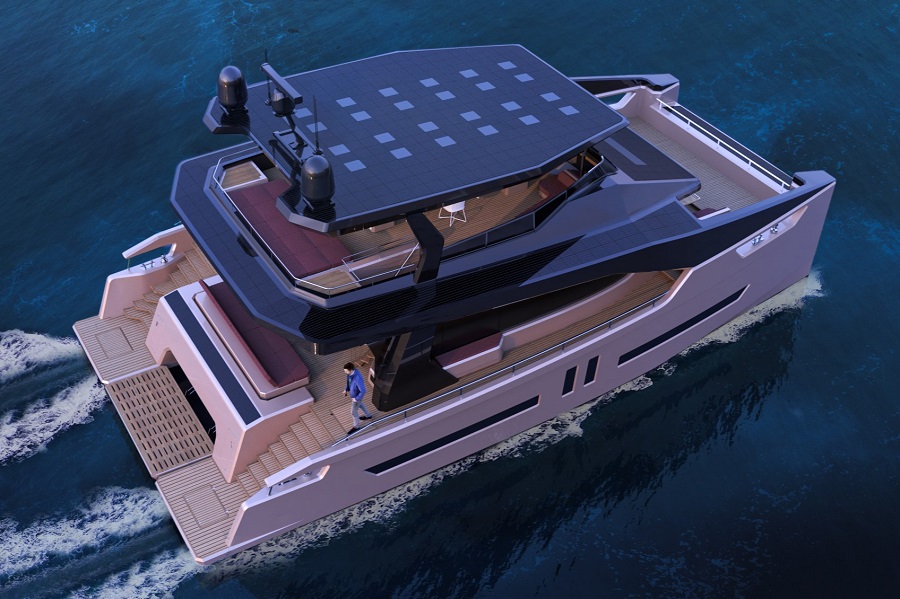
CGI of Alva Ocean Eco 60
Alva Yachts, founded in 2020 by Managing Director Mathias May and CEO Holger Henn, is preparing to launch its first Ocean Eco 60 solar-electric catamaran, in build in Turkey’s Antalya Free Zone.
The 18.4m model has a 10.2m (33ft 6in) beam and is available with an open or enclosed flybridge or as a coupé. The German-owned company is also building the Ocean Eco 90 series and recently revealed designs for the Ocean Eco 78, a 23.7m model with a 12m beam.
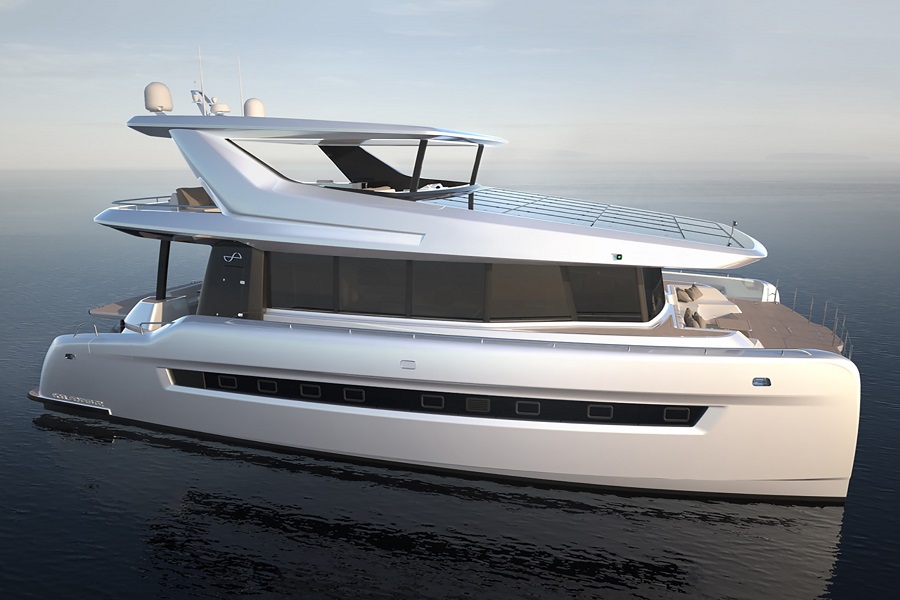
CGI of Soel Senses 62
Dutch-owned Soel Yachts has designed and engineered the Senses 48 and Senses 82 solar-electric catamarans, but is most actively promoting its Senses 62, which is listed by Ocean Independence and features 42 solar panels generating 18.5kWp.
Soel has previous built several passenger vessels including the SoelCat 12 and Shuttle 14, and built a custom-designed 10m carbon-fibre speedboat for private use.
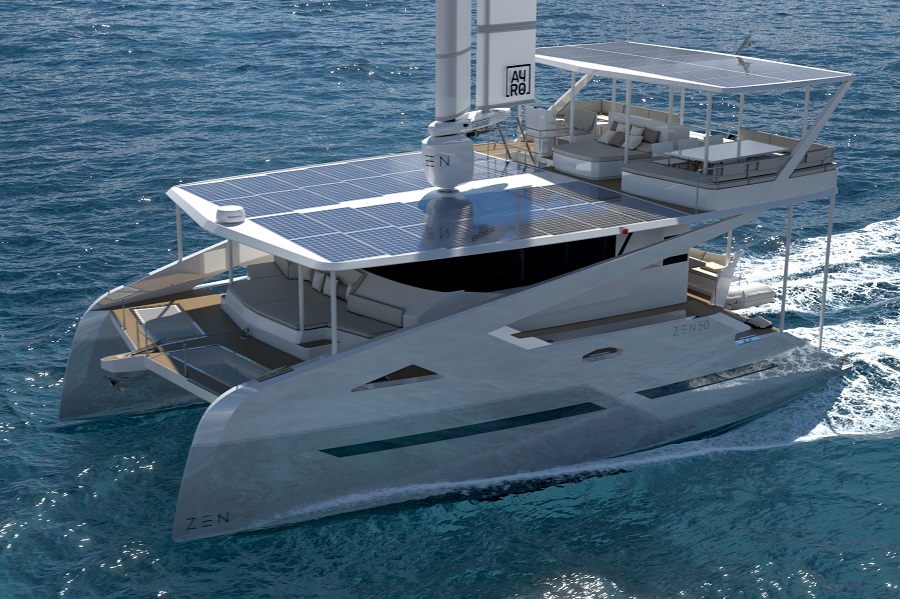
CGI of Zen 50
Headquartered in Barcelona, Zen Yachts is scheduled to deliver the first two units of the solar-electric Zen 50 in the first half of 2024, having announced a €5.5 million funding round from Ocean Zero LLC earlier this year.
Designed by Julien Mélot, the 15.7m (51ft 6in) cat has an 8.4m (27ft 7in) beam, lightweight carbon hulls and a semi-rigid Ayro Oceanwings32 wingsail that can be controlled at the upper and lower helm stations. A huge flat roof and a hardtop above the flybridge enable extensive solar panel coverage that can generate 16kW.
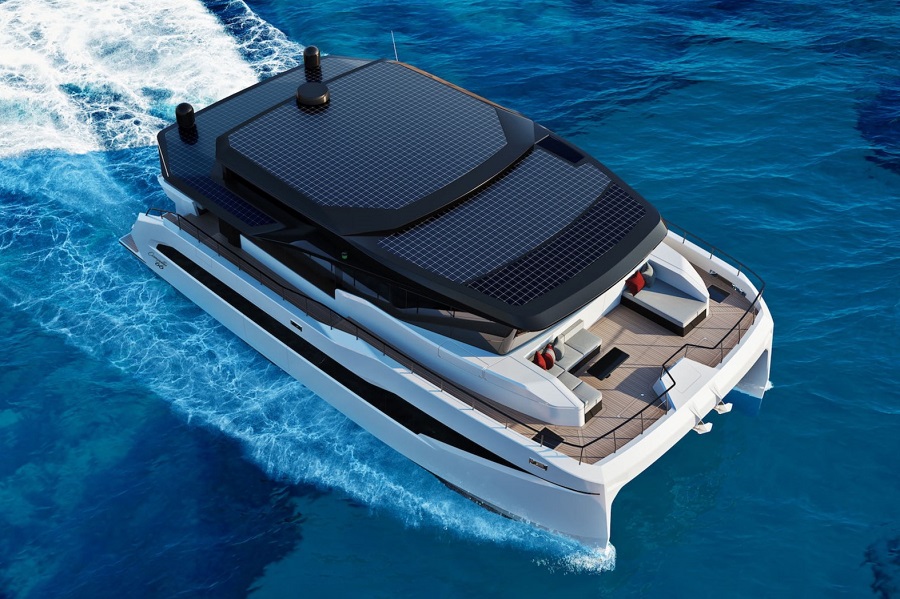
CGI of Cosmopolitan 66
Also in Spain, Cosmopolitan Yachts, spearheaded by Ivan Salas of Iddes Yachts and German entrepreneur Christian Braun, is developing the aluminium, solar-electric Cosmopolitan 66, which can house up to six guest cabins.
Featuring a beam of 10.67m (35ft), the 20.1m yacht has a 1m-plus bridgedeck clearance, a foil below the aft end of both hulls and 17kWp of solar panel coverage.
Note: The original article appears in YACHT STYLE Issue 71 (click to read)